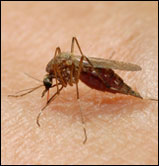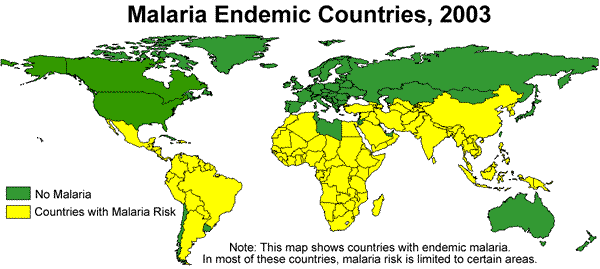A Day in the Life of a Parasite ~ Habitat |
 P. falciparum is most often found in areas that are comperable to the
lifestyle of the vector that transmits it. Since P. falciparum is carried by infected female
Anopheles gambiae mosquitoes to the vertebrate human host, tropical and subtropical areas are the most greatly affected
(CDC). Specific countries that are highly affected are "tropical regions of
China, India, Southeast Asia, and South and Central America" (MVI).
Sub-Saharan Africa also contains a high occurrence rate (MVI). The Center for
Disease Control (CDC) states that due to global warming and climate
changes the niches may spread out to farther countries. An increase in travel
and lack of knowledge of transport precautions also increases the risk
for other countries. P. falciparum is most often found in areas that are comperable to the
lifestyle of the vector that transmits it. Since P. falciparum is carried by infected female
Anopheles gambiae mosquitoes to the vertebrate human host, tropical and subtropical areas are the most greatly affected
(CDC). Specific countries that are highly affected are "tropical regions of
China, India, Southeast Asia, and South and Central America" (MVI).
Sub-Saharan Africa also contains a high occurrence rate (MVI). The Center for
Disease Control (CDC) states that due to global warming and climate
changes the niches may spread out to farther countries. An increase in travel
and lack of knowledge of transport precautions also increases the risk
for other countries.
|
|
|
| Since P. falciparum is a parasite its main habitat is in another living organism. It accomplishes this by switching between the human host and mosquito host during life cycle. While in the host it can cause many different ailments, even death. For more information on its life in the human view Nutrition.
|
